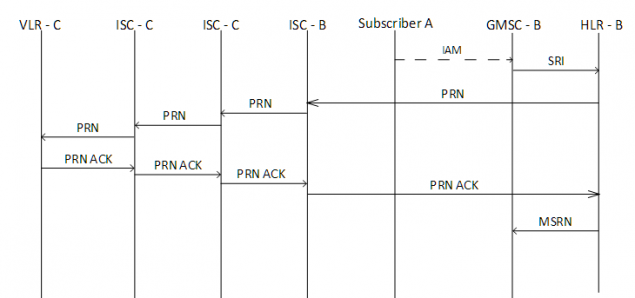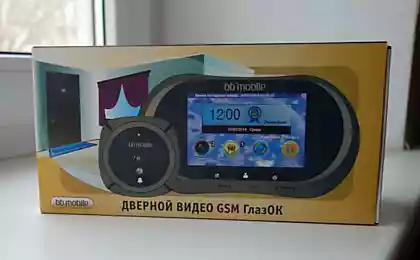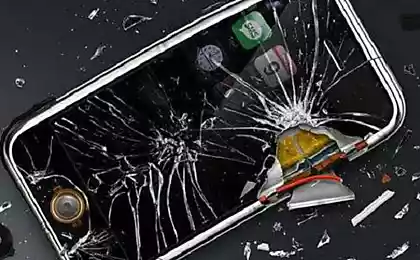2285
How does international roaming
In this article I will talk about how the service is international roaming and how the call and SMS while roaming. Spells out abbreviations can be found in the this article.
About the Service h4> Roaming - a service that allows subscribers to make calls, receive data, use other services provided by the operator in the networks of other operators, including foreign ones, with which the operator has a roaming subscriber agreement. In this case, the phone number remains the same.
Authorization h5> The first action that occurs when trying to create a network of foreign partner - a test of the subscriber to the "validity". This deals VLR / MSC, within the range of which is MS. After guest VLR / MSC receives a command «Location Update» from the MS, knowing IMSI subscriber sends a message to MAP «Send Authentication Info» on HLR; it is, in turn, checks that the MS and the obtained actual IMSI. If the test is successful and the user is "valid», HLR sends the IMSI AUC. AUC generates triplet (SRES, RAND, Kc) and sends it to the HLR, then the HLR sends the data to the VLR / MSC, that serves the MS. When the VLR / MSC has received these data, VLR / MSC sends the RAND to MS. When prompted RAND, MS substitutes obtained RAND and Ki (recorded on the SIM card) and calculates SRES, which sends a VLR / MSC. If the SRES, obtained from the MS, the same as the SRES, obtained by AUC, while MS is considered authorized.
Update Location h5> After VLC / MSC authorized the MS, it sends a message to the home HLR «Update Location». This message is sent to HRL known in the zone of a VLR / MSC the subscriber. Message «Update Location» contains the IMSI of the subscriber and GT VLR / MSC. HLR, received data, check whether the service is connected roaming. If the subscriber is no ban, the HLR removes the subscriber profile from the VLR / MSC, where the subscriber is registered to this procedure by sending a message «Cancel Location». Also HLR with a message «Insert Subscriber Data» sends the subscriber profile to request this information VLC / MSC. After the VLR / MSC receives this information, «Update location» will be completed, and the HLR will keep in your profile subscriber address VLR / MSC, requesting Update location. At this stage, «Update Location» finished. When you receive a call or SMS HLR knows what VLR / MSC send it.
Incoming call h5> From A subscriber receives a call to the subscriber B, who is roaming. A subscriber dials the subscriber A (MSISDN). If it is a challenge to urban network, the ISUP IAM message to arrive GMSC, GMSC further specifies the address of the HLR based on the obtained MSISDN and sends a message «sendRoutingInfo» MAP protocol to HLR. HLR, receiving MSISND, determines the IMSI subscriber B, and in which VLR / MSC the subscriber. Next, the HLR sends to the VLR / MSC message «ProvideRoamingNumber» MAP protocol that contains the subscriber's IMSI B. Post «ProvideRoamingNumber» is used to request a temporary number MSRN from a pool of numbers registered in the VLR / MSC. MSRN has a format (GT) of the country in which the VLR / MSC, serving the subscriber. MSRN is issued at the time of call set-up, then falls into a pool of numbers MSRN.
Outgoing call h5> A subscriber while roaming, caller B. When an outgoing call first thing in place procedures and Authorization Update Location, described above. The first thing VLR / MSC, which registered user A sends a message «sendRoutingInfo» (which contains called MSISDN B) in the GMSC. GMSC, in turn, sends an ISUP IAM to the number MSISDN. If MSISND belongs to a wired network, the call goes to service this PBX subscriber number. If the cellular operator MSISDN belongs, the message goes to GMSC IAM subscriber B. Then, the GMSC sends an inquiry «sendRoutingInfo» HLR in order to learn the address of VLR / MSC, the serving subscriber B and IMSI. Once this information has provided HLR, GMSC sends the IAM to the VLR / MSC.
Outgoing SMS h5> A subscriber while roaming, sends an SMS to the subscriber B. After the VLR / MSC received a message from someone who passes it through to the SMSC provider SCCP home network via GMSC. SMSC sends the message «sendRoutingInfoForSM» in the HLR subscriber B, then HLR responds with an address VLR / MSC (in the zone of which the subscriber B) and IMSI SMS center. Next SMSC sends the message «forwardSM» on the VLR / MSC subscriber B.
Incoming SMS h5> A subscriber sends an SMS to B, which is roaming. The principle is similar to that described in an outgoing message. From A subscriber via the SMSC provider receives SCCP message «sendRoutingInfoForSM» to GMSC, and then VLR / MSC, in whose area the subscriber B. Thereafter, VLR / MSC responsible IMSI and its location. After this procedure from the SMSC A subscriber receives a message «forwardSM». VLR / MSC, having received this message, makes an attempt to deliver the message of the subscriber. If the message is delivered, VLR / MSC responds «forwardSM END».
About the Service h4> Roaming - a service that allows subscribers to make calls, receive data, use other services provided by the operator in the networks of other operators, including foreign ones, with which the operator has a roaming subscriber agreement. In this case, the phone number remains the same.
The National roumin i> g - is an opportunity to use "foreign" network within the same country.
International roaming i> - it is an opportunity to use the mobile network of a foreign operator, with which there is agreement. This article will describe this type of roaming.
Authorization h5> The first action that occurs when trying to create a network of foreign partner - a test of the subscriber to the "validity". This deals VLR / MSC, within the range of which is MS. After guest VLR / MSC receives a command «Location Update» from the MS, knowing IMSI subscriber sends a message to MAP «Send Authentication Info» on HLR; it is, in turn, checks that the MS and the obtained actual IMSI. If the test is successful and the user is "valid», HLR sends the IMSI AUC. AUC generates triplet (SRES, RAND, Kc) and sends it to the HLR, then the HLR sends the data to the VLR / MSC, that serves the MS. When the VLR / MSC has received these data, VLR / MSC sends the RAND to MS. When prompted RAND, MS substitutes obtained RAND and Ki (recorded on the SIM card) and calculates SRES, which sends a VLR / MSC. If the SRES, obtained from the MS, the same as the SRES, obtained by AUC, while MS is considered authorized.

Update Location h5> After VLC / MSC authorized the MS, it sends a message to the home HLR «Update Location». This message is sent to HRL known in the zone of a VLR / MSC the subscriber. Message «Update Location» contains the IMSI of the subscriber and GT VLR / MSC. HLR, received data, check whether the service is connected roaming. If the subscriber is no ban, the HLR removes the subscriber profile from the VLR / MSC, where the subscriber is registered to this procedure by sending a message «Cancel Location». Also HLR with a message «Insert Subscriber Data» sends the subscriber profile to request this information VLC / MSC. After the VLR / MSC receives this information, «Update location» will be completed, and the HLR will keep in your profile subscriber address VLR / MSC, requesting Update location. At this stage, «Update Location» finished. When you receive a call or SMS HLR knows what VLR / MSC send it.
After these procedures, the subscriber will be registered on the network, ie, he can make and receive calls, SMS, use other available services. Consider the detailed procedures for incoming and outgoing calls.

Incoming call h5> From A subscriber receives a call to the subscriber B, who is roaming. A subscriber dials the subscriber A (MSISDN). If it is a challenge to urban network, the ISUP IAM message to arrive GMSC, GMSC further specifies the address of the HLR based on the obtained MSISDN and sends a message «sendRoutingInfo» MAP protocol to HLR. HLR, receiving MSISND, determines the IMSI subscriber B, and in which VLR / MSC the subscriber. Next, the HLR sends to the VLR / MSC message «ProvideRoamingNumber» MAP protocol that contains the subscriber's IMSI B. Post «ProvideRoamingNumber» is used to request a temporary number MSRN from a pool of numbers registered in the VLR / MSC. MSRN has a format (GT) of the country in which the VLR / MSC, serving the subscriber. MSRN is issued at the time of call set-up, then falls into a pool of numbers MSRN.
After MSRN was isolated, it is sent to the HLR; HLR in turn sends the MSRN to the GMSC. GMSC routes the call to the MSRN to the VLR / MSC, serving subscriber B by sending an IAM message to the ISUP highlighted MSRN.

The paper procedure paging and call set-up on the ISUP not be considered.
Outgoing call h5> A subscriber while roaming, caller B. When an outgoing call first thing in place procedures and Authorization Update Location, described above. The first thing VLR / MSC, which registered user A sends a message «sendRoutingInfo» (which contains called MSISDN B) in the GMSC. GMSC, in turn, sends an ISUP IAM to the number MSISDN. If MSISND belongs to a wired network, the call goes to service this PBX subscriber number. If the cellular operator MSISDN belongs, the message goes to GMSC IAM subscriber B. Then, the GMSC sends an inquiry «sendRoutingInfo» HLR in order to learn the address of VLR / MSC, the serving subscriber B and IMSI. Once this information has provided HLR, GMSC sends the IAM to the VLR / MSC.
Outgoing SMS h5> A subscriber while roaming, sends an SMS to the subscriber B. After the VLR / MSC received a message from someone who passes it through to the SMSC provider SCCP home network via GMSC. SMSC sends the message «sendRoutingInfoForSM» in the HLR subscriber B, then HLR responds with an address VLR / MSC (in the zone of which the subscriber B) and IMSI SMS center. Next SMSC sends the message «forwardSM» on the VLR / MSC subscriber B.
Incoming SMS h5> A subscriber sends an SMS to B, which is roaming. The principle is similar to that described in an outgoing message. From A subscriber via the SMSC provider receives SCCP message «sendRoutingInfoForSM» to GMSC, and then VLR / MSC, in whose area the subscriber B. Thereafter, VLR / MSC responsible IMSI and its location. After this procedure from the SMSC A subscriber receives a message «forwardSM». VLR / MSC, having received this message, makes an attempt to deliver the message of the subscriber. If the message is delivered, VLR / MSC responds «forwardSM END».
Home Routing
When "houmrutinge» HLR provides a dummy IMSI and address of the VLR / MSC. SMS is fed to the virtual MSC, and then transmits the virtual MSC to a real SMS MSC.
Source: habrahabr.ru/post/228527/
Lively: clever gadget that tells you when an older person needs help
Interplanetary probe Rosetta: the first data to study the comet Churyumov-Gerasimenko

























